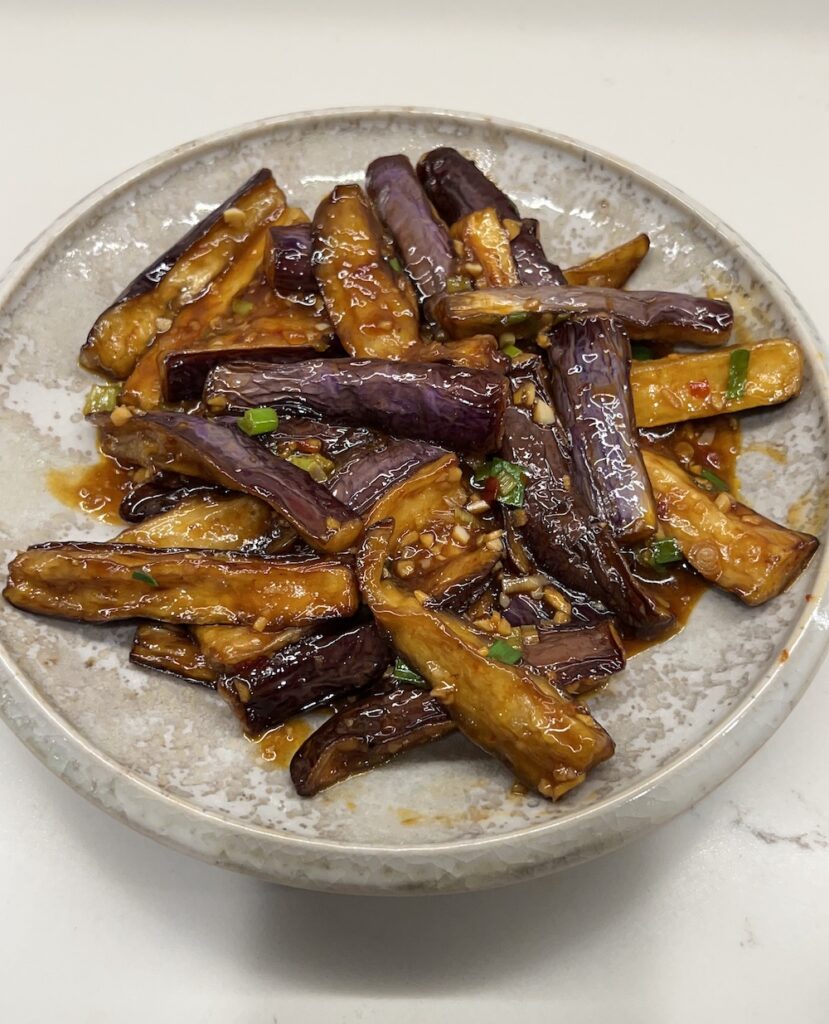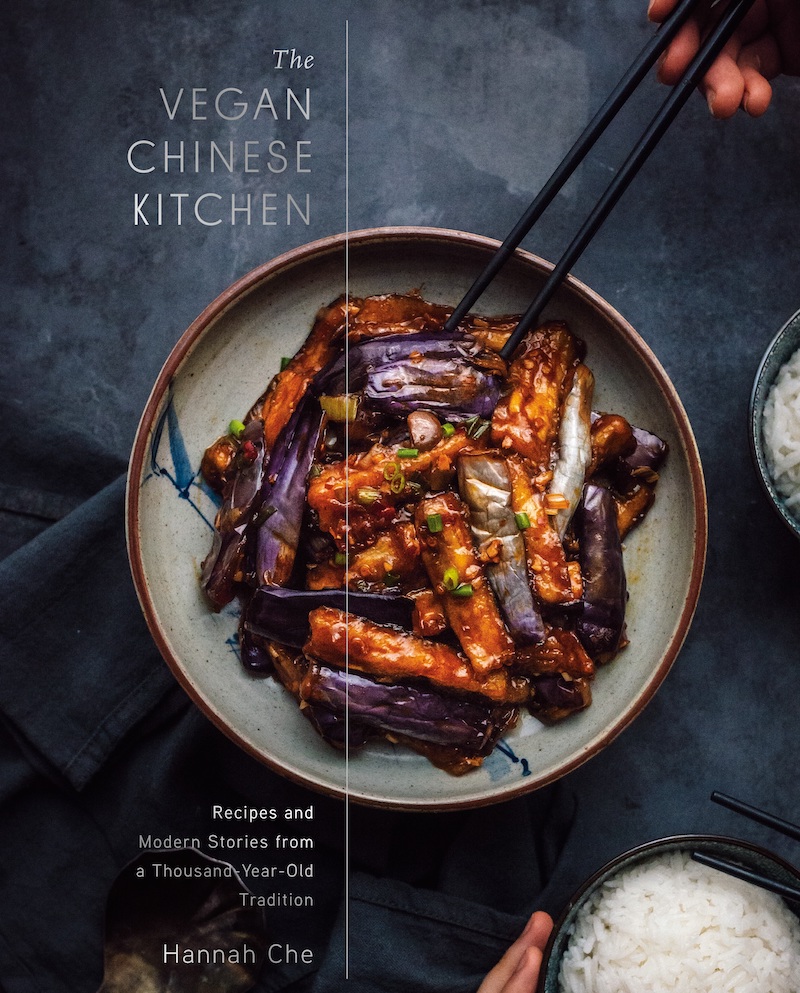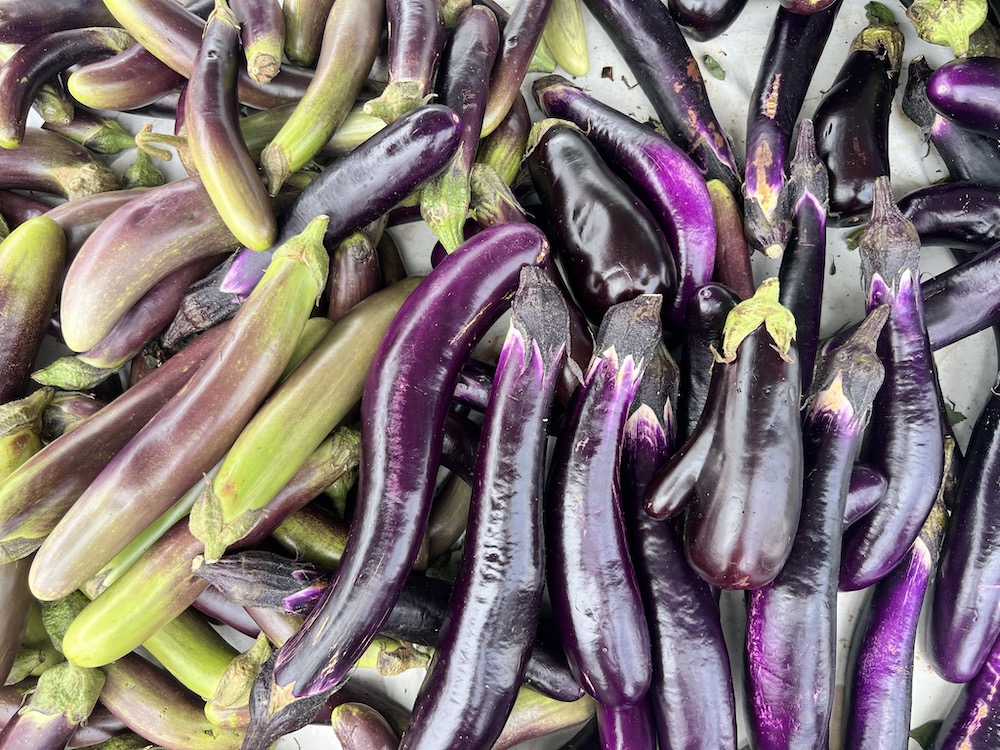
Many delicious Asian dishes are misunderstood and this is one of them. The Mandarin name, yúxiāng qiézi (魚香茄子), literally means fish-fragrance eggplant but there is no fish involved. According to cookbook author Hannah Che, the Chinese culinary notion of a fish fragrant dish originated "along the coast of the Yangtze River in Sichuan, where fishermen often cooked the fish they caught using a pungent mixture of chiles, ginger, and garlic." Ingredients cooked in a similar combination of ingredients is described as having a Sichuanese “fish-fragrant” flavor that's uniquely piquant, tart, and sweet.
Look in Chinese cookbooks and on menus and you'll often see "fish fragrance" dishes. At restaurants, this eggplant dish generally contains pork too and is greasy and heavy. Not Hannah's vegan take, which is from her stellar debut cookbook, The Vegan Chinese Cookbook.

Her recipes are for everyone. This one is luscious, meaty, and full of bells and whistles. It's worthy of entertaining special guests. But I prefer to make a batch for our household of two to serve as a main dish along with some steamed or boiled greens and rice. That's a luxe and doable weeknight meal.
Why deep-fry the eggplant?
The fast and undramatic frying seals the exterior to create a creamy interior for each eggplant piece. The result is meltingly rich, practically like pork fat that you don't mind eating. Soaking the eggplant in salt water helps keep it from soaking up too much oil. Once the eggplant is fried, it can sit for a little bit before you finish with the final stir-frying. See the video below.
What kind of eggplants to use?
Chinese eggplants are my first choice but the purplish Filipino ones would be great too. Both have thin-ish skin. Japanese eggplants have thicker skin so I would avoid them here. An Italian eggplant would work too. Below are eggplants grown by a Hmong farmer. The selection is pretty typical in California at farmer's markets. Asian markets mostly have Chinese and Japanese eggplants. Occasionally, there are Filipino eggplants too.

What is the difference between Fish-Fragrance and Eggplant in Garlic Sauce?
They are the same dish if you look at the Chinese characters. "Eggplant in Garlic Sauce" is a friendlier name for the dish. The recipe here is great and requires no deep-frying but Hannah's is remarkable and excellent.
Fish-Fragrance Eggplant Recap Video
Here's how the dish comes together in my home kitchen. Remember to select "stay" when prompted or you'll be shuffled into a new video! Hope all of this encourages you to make this Chinese favorite.
Fish-Fragrant Eggplant
Ingredients
THE SAUCE
- ½ cup unsalted stock of any kind or water
- 1 tablespoon sugar
- 1 tablespoon soy sauce
- 1 tablespoon Chinkiang black vinegar or 1 ½ teaspoons balsamic vinegar and 1 ½ teaspoons rice vinegar
- ½ teaspoon potato starch
The eggplant and stir-frying ingredients
- 1 pound long Chinese or Japanese eggplants (about 3 small)
- Fine sea salt
- Vegetable oil for frying
- ¼ to ½ cup potato starch or cornstarch
- 1 ½ tablespoons Sichuan chili bean paste or pickled chili paste, see Note
- 1 tablespoon finely chopped garlic
- 1 tablespoon finely chopped fresh ginger
- 2 green onions, thinly sliced, white and green parts kept separate
Instructions
- MAKE THE SAUCE: In a small bowl, whisk all the sauce ingredients until blended. Set aside.
- Cut the eggplants lengthwise into 3-inch sections, then slice them into ½-inch wedges. In a large bowl, combine 3 cups water and 2 teaspoons fine sea salt and whisk until the salt dissolves, then submerge the eggplant and soak for 15 minutes. Drain and pat the wedges dry. Salting helps relax the flesh, reduce any bitterness, and prevent it from soaking up excessive oil.
- Heat about 1 inch of oil (roughly 1 ½ cups) in a wok or skillet over medium-high heat. Coat the eggplant lightly in the starch. When the oil reaches 375°F, fry the eggplant in batches, flipping and turning it occasionally to cook evenly, until the edges are slightly golden and the skin is glossy purple and wrinkled, 3 to 4 minutes. Transfer the cooked eggplant to a paper towel–lined plate. Pour the oil through a paper towel lined strainer set over a bowl and reserve for another use. Wipe the wok clean then return 1 tablespoon oil to the wok.
- Return the wok to the stove over medium heat and add the chili bean paste. Stir-fry over low heat until its red oil is released, about 30 seconds. Add the garlic, ginger, and scallion whites and stir-fry until just aromatic, about 30 seconds more. Push the aromatics up one side of the wok and pour the sauce mixture into the center.
- Gently fold the fried eggplant into the sauce and simmer for about 2 minutes, until the eggplant has absorbed the flavors and the liquid is thickened from the starch. Transfer to a plate, garnish with the scallion greens, and serve immediately.

















